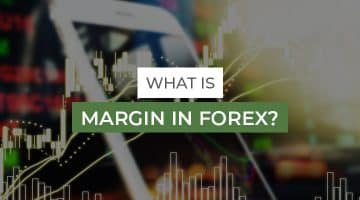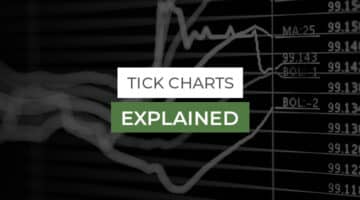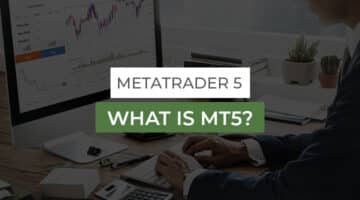Forex Tick Volume Explained

In this article
Forex trading is all about volume. Financial institutions, banks, retail traders all make the forex volume. Tracking down the real-time forex volume is difficult, and what we need is a non-lagging indicator that solves our problems. Along comes tick volume to the rescue.
In this guide, we are going to explain all the details you want to know about the forex tick volume.
Before dwelling on tick volume, it’s important to discuss what the hell is a trading volume.
Volume is the fuel that causes new trading cycles and tells us whether the market is on the buy or sell side.
One of the most valuable skills every forex trader can acquire is how trading volume affects the currency market.
The greater the volume, the simpler it is to buy or sell. If there are fewer buyers and sellers, you are less likely to acquire the price you desire. To move a market, volume is essential.
Trading volume
When marketplaces overlap, such as the London-New York overlap or the Tokyo-London overlap, there is a lot of volume.
Volume is sometimes disregarded in favour of price activity, yet the two may be a fatal combination for any trader.
Volume has an impact on market pricing since it indicates the engagement of major participants.
We can piggyback on the market biases of large players.
Now let’s move to tick volume.
What is a tick volume?
A tick volume is a measurement of the smallest upward or downward fluctuation in the price of a currency pair.
It also refers to the fluctuation in a security’s price from one trade to the next.
There are two types of tick volume; uptick and downtick.
An uptick is a forex pair trade that is conducted at a higher price than the prior trade.
A downtick is a forex pair transaction that occurs at a lower price than the prior transaction.
The disparity between tick volume and real volume is actually rather large, with some claiming that it can be as much as 90%.
How to use a forex tick volume?
The most important thing for you as a trader is to find the entry point. Some pull the trigger immediately, while others wait for the confirmation to appear. And that’s is exactly what tick volume tells you.
If we see price approaching a key decision point on lower or decreasing tick volume, we are likely to find ourselves in a situation where that level will be rejected.
This type of price acceleration without accompanying volume tends to paint a deceptive picture of market intentions, and it is certainly not one that piques the curiosity of smart money. Smart money refers to trade from big players like financial institutions and banks.
The low tick volume is due to the price action‘s refusal to participate in the move. The lack of this volume riding the move leads to thinner market liquidity, which allows for more price extension even on modest volumes.
On the other hand, if the price swings towards a decision point or a level is broken amid larger or increasing tick volume, it usually indicates that the bias has the backing of institutional money. When this occurs, the growing tendency will likely continue.
When trading with the tick volume, there are candlesticks that can tell you the volume’s intensity.
Let’s define each of them:
1. Absorption candle
If we see a volume that stands out above the rest at a critical decision moment, with a sizeable tail of at least 12 the size of the candle, we get what is known as an absorption candle.
The below chart illustrates how a tremendous amount of selling pressure was applied, but buy orders ended up overwhelming buyers.
2. Volume candle
A stopping volume candle is another candle structure that delivers a message similar to the absorption candle.
This is a high-volume move, but the candle size is significantly smaller this time. Therefore, it isn’t necessary to have a tail.
Just look at the volume!
3. Real-money candle
The real-money candle is another type of price formation that will be shouting at you. Its distinguishing feature is the large candle, which is accompanied by ballooning volume.
Because this configuration has very little, if any, absorption, it signals that the demand/supply imbalance has far outweighed the opposing side.
When these candles appear, one can anticipate a limited continuance of the trend. They can only be built with the help of the smart money community.
As momentum traders jump on the bandwagon, this candle formation tends to continue longer with little pullback if there is adequate space till the next target area.
However, unless you are a short-term momentum trader, it normally retraces due to over-extended conditions, and that is where swing traders and the smart money will try to re-engage.
4. Exhaustion candle
The exhaustion candle is the next price structure on the list. If the price reaches a decision point in the midst of low volume action, the prospects of the area being violated are quite limited.
Sellers simply exhaust themselves, as the word implies. As a result, the price discovery dynamics will cause the price to retreat, hunting for fills at the next optimal places of stability.
Pros of tick volume
- Given the scarcity of real volume information in the forex market, retail traders can rely on tick volume as the best indication of this real volume.
Cons of tick volume
- The broker’s data feed is the most important aspect in determining tick volume figures. Unfortunately, forex brokers apply a number of data feed that is based on various combinations of liquidity providers. As a result, there are inconsistencies between what tick volume indicates at one broker and another; these disparities can be pretty big.
Bottom line
If you are trading with the tick volume, spend time studying your charts using tick volume data.
What’s your entry and exit point? What timeframe will you use? Are you a scalper, day-trader or position trader?
These are the questions you need to ask before trading with the tick volume.
Jason Morgan is an experienced forex analyst and writer with a deep understanding of the financial markets. With over 13+ years of industry experience, he has honed his skills in analyzing and forecasting currency movements, providing valuable insights to traders and investors.
Forex Content Writer | Market Analyst
Relevant Posts

Market Technical Analysis
[top_three_brokers] Whenever someone starts their trading journey, they open a chart, and clouds of disbelief…
Read more

Major Currency Pairs Traded in South Africa
[top_three_brokers] When selecting the best major currency pairs traded in South Africa for beginners, you…
Read more

Should I Use a No Deposit Bonus?
[top_three_brokers] The term “no deposit bonus” refers to the fact that new traders can open…
Read more

What is a lot in Forex – Lots sizes Explained
[top_three_brokers] One of the basic terms that you are sure to come across time and…
Read more

How to Start Forex Trading?
[top_three_brokers] Your quick guide to Forex trading in South Africa, answering the big question on…
Read more

How does a No Deposit Bonus Work?
[top_three_brokers] Who doesn't love free cash! And what if you can get that free cash…
Read more

What is Margin in Forex?
[top_three_brokers] What is margin in Forex and how to avoid receiving a dreaded margin call…
Read more

Tick Chart Explained
[top_three_brokers] As a trader, you use a wide variety of charts to analyse markets. If…
Read more

MetaTrader 5 – What is MT5?
[top_three_brokers] MetaTrader 5 is a multi-asset, multi-functional trading platform used by traders from around the…
Read more

Stop Loss and Take Profit – How Do You Set It?
[top_three_brokers] As a trader, the most important role is to manage and protect your trading…
Read more

Market Technical Analysis
[top_three_brokers] Whenever someone starts their trading journey, they open a chart, and clouds of disbelief…

Major Currency Pairs Traded in South Africa
[top_three_brokers] When selecting the best major currency pairs traded in South Africa for beginners, you…

Should I Use a No Deposit Bonus?
[top_three_brokers] The term “no deposit bonus” refers to the fact that new traders can open…

What is a lot in Forex – Lots sizes Explained
[top_three_brokers] One of the basic terms that you are sure to come across time and…

How to Start Forex Trading?
[top_three_brokers] Your quick guide to Forex trading in South Africa, answering the big question on…

How does a No Deposit Bonus Work?
[top_three_brokers] Who doesn't love free cash! And what if you can get that free cash…

What is Margin in Forex?
[top_three_brokers] What is margin in Forex and how to avoid receiving a dreaded margin call…

Tick Chart Explained
[top_three_brokers] As a trader, you use a wide variety of charts to analyse markets. If…

MetaTrader 5 – What is MT5?
[top_three_brokers] MetaTrader 5 is a multi-asset, multi-functional trading platform used by traders from around the…

Stop Loss and Take Profit – How Do You Set It?
[top_three_brokers] As a trader, the most important role is to manage and protect your trading…





